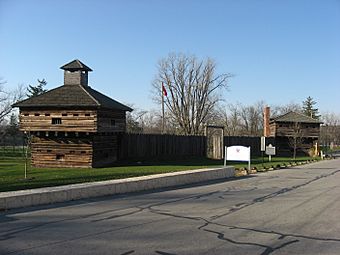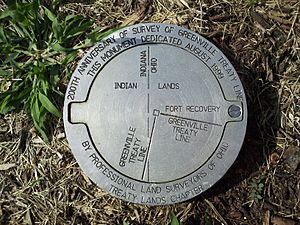Fort Recovery facts for kids
Quick facts for kids |
|
|
Fort Recovery Site
|
|

Blockhouses and stockade walls at the reproduction of Fort Recovery
|
|
| Location | State Route 49, Fort Recovery, Ohio |
|---|---|
| Area | 5 acres (2.0 ha) |
| Built | 1791 |
| NRHP reference No. | 70000509 |
| Added to NRHP | November 10, 1970 |
Fort Recovery was an important United States Army fort built during a time known as the Northwest Indian War. General "Mad" Anthony Wayne ordered its construction. The fort was built between late 1793 and March 1794. It stood along the Wabash River, close to where Ohio and Indiana meet today.
In June 1794, a group of Wayne's soldiers, called the Legion of the United States, successfully defended the fort. They fought off an attack from several Native American tribes. Fort Recovery was so important that it was used as a landmark when drawing the borders for the 1795 Treaty of Greenville. This treaty helped shape the future of the region. The fort was no longer used after 1796.
Today, the town of Fort Recovery, Ohio has grown up around the old fort site. It has special places and monuments to remember the fort and the battles that happened there.
Fort Recovery: A Historic Frontier Post
Why Fort Recovery Was Built
The Battle That Led to the Fort
General Wayne chose a very specific spot for Fort Recovery. It was the exact place where General Arthur St. Clair had suffered a major defeat in 1791. In that battle, Native American tribes, led by Miami Chief Michikinikwa (Little Turtle) and Shawnee Chief Weyapiersenwah (Blue Jacket), won a big victory. This event, known as St. Clair's Defeat, ended St. Clair's military career. It also made the United States Congress investigate what went wrong.
General Wayne's New Army
Because of this Native American victory, a new army was formed. It was called the Legion of the United States, and General "Mad Anthony" Wayne was put in charge. Wayne wanted to show that the U.S. Army could bounce back and win. This conflict was also sometimes called "Little Turtle's War."
In late 1793, Wayne led 300 soldiers to the site of St. Clair's defeat. He purposely had Fort Recovery built right there. On December 25, they found the site because of many unburied remains from the earlier battle. One soldier, Private George Will, wrote that they had to move bones to make room for their beds.
The Attack on Fort Recovery
A Surprise Attack
Fort Recovery had about 250 soldiers from General Wayne's army stationed there since spring 1794. On June 30, 1794, a group of U.S. soldiers left Fort Recovery. They were taking supplies to another fort, Fort Greenville. Major William McMahon led this group, which included riflemen and soldiers on horseback called dragoons.
They had only gone a short distance when Native American warriors attacked them. Shawnee war chief Blue Jacket led the attack, and the young Tecumseh was also there. The dragoons quickly retreated back to the fort. They lost 32 soldiers, including Captain Hartshome, and 30 were wounded. The number of Native American casualties is not known.
Holding the Fort
During the night, a scouting team reported something interesting. They saw British officers with the Native American forces. These officers had brought gunpowder and cannonballs, but no cannons. The Native Americans were actually looking for U.S. cannons that had been buried after St. Clair's defeat. However, Wayne's army had already found and recovered these cannons.
The next day, July 1, the Native American forces attacked the fort again. But they started to leave by noon and were completely gone by nightfall. The U.S. soldiers successfully defended Fort Recovery. They were able to keep control of the fort, partly because they had those recovered cannons. Wayne then used Fort Recovery as a base to move further into the territory. He eventually defeated the Native American alliance at the Battle of Fallen Timbers in August 1794.
Fort Recovery and the Treaty of Greenville
After Wayne's victory at the Battle of Fallen Timbers, the U.S. offered peace. This led to the 1795 Treaty of Greenville with the Native American tribes in the region. Fort Recovery was a very important landmark for this treaty. It was used to draw the boundary line between U.S. territory and Native American lands.
Later, in 1800, the fort helped define the first borders of the Indiana Territory. This was when Indiana was separated from the larger Northwest Territory. When Ohio became a state in 1803, its western border was set a few miles west of Fort Recovery.
Remembering Fort Recovery Today
The Fort Recovery Monument
In 1891, people dug up the battle sites around the fort. The remains of about 1200 people were buried in a special memorial park in downtown Fort Recovery. In 1908, President William Howard Taft signed a law to build a monument. This monument would honor those who died under Arthur St. Clair and Anthony Wayne at Fort Recovery. In 1910, his government gave the village $25,000 to create it.
The monument is a tall, four-sided pillar called an obelisk. It was built in 1912 and officially opened on July 1, 1913. The obelisk stands about 101 feet (30.9 meters) tall. It weighs around 800 short tons (725 metric tons) and cost $23,700 to build. Today, this monument is part of the Fort Recovery State Memorial. The Ohio Historical Society takes care of it. There is also a replica of Wayne's fort, with two rebuilt blockhouses and a connecting stockade fence.
Exploring the Fort Recovery Museum
The Fort Recovery State Museum opened in 1938 during the Great Depression. It has life-size dioramas, which are 3D models, showing fort soldiers and the different Native American tribes involved in the fighting. The museum's exhibits explain Wayne's military campaign. They include military and Native American items, uniforms, weapons, paintings, and maps. The museum also has a gift shop and offers special programs for school groups.
In 2011, students from Ball State University found the original location of one of the fort's walls. It was not far from the Fort Recovery state museum.
See also




